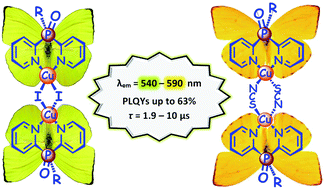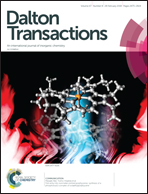Bright green-to-yellow emitting Cu(i) complexes based on bis(2-pyridyl)phosphine oxides: synthesis, structure and effective thermally activated-delayed fluorescence†
Abstract
A family of brightly luminescent dinuclear complexes of [Cu(μ2-X)(N^N)]2 type (X = I or SCN) has been synthesized in 76–90% yields by the reaction of bis(2-pyridyl)phosphine oxides (N^N) with the corresponding Cu(I) salts. The X-ray diffraction study reveals that the Cu2I2 core of the [Cu(μ2-I)(N^N)]2 complexes has either a butterfly- or rhomboid-shaped structure, while the eighth-membered [Cu(SCNNCS)Cu] ring in the [Cu2(SCN)2(N^N)]2 complexes is nearly planar. In the solid state, these compounds exhibit a strong green-to-yellow emission (λemmax = 536–592 nm) with high PLQYs (up to 63%) and short lifetimes (1.9–10.0 μs). The combined photophysical and DFT study indicates that the ambient-temperature emission of the complexes obtained can be assigned to the thermally activated-delayed fluorescence (TADF) from the 1(M + X)LCT excited state, while at 77 K, phosphorescence from the 3(M + X)LCT state is likely observed.



 Please wait while we load your content...
Please wait while we load your content...